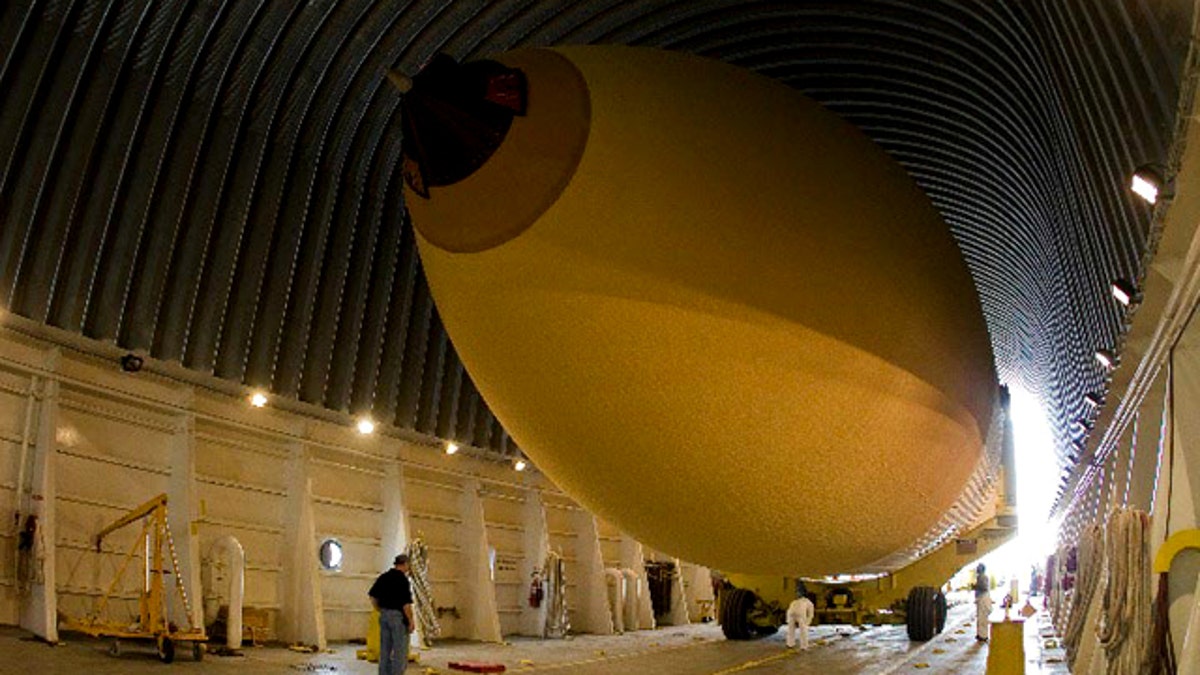
Space shuttle Discovery's external fuel tank, ET-137, is loaded into its Pegasus barge at the Michoud Assembly Facility in New Orleans for shipment to NASA's Kennedy Space Center. The planned 6-day delivery was hampered by a massive oil spill in the Gulf of Mexico, which forced NASA to hire a commercial tug for part of the journey. (Lockheed Martin)
The massive oil spill plaguing the United States Gulf Coast has also thrown a wrench in NASA's plans to deliver a huge space shuttle fuel tank from Louisiana to Florida for the last launch of shuttle Discovery in September.
The expanding oil slick has cut into the deep water route typically used by NASA barges and their tugs to haul the 15-story space shuttle fuel tanks from their manufacturing site -- the Michoud Assembly Facility in New Orleans -- to the Kennedy Space Center in Florida to be attached to an orbiter for launch.
Space shuttle program manager John Shannon said Monday that NASA's recovery ship Freedom Star -- one of two ships that deliver shuttle fuel tanks as well as retrieve an orbiter's twin reusable solid rocket boosters from the Atlantic Ocean after a launch -- is not equipped to make the shallow-water detour around the oil spill.
"It's kind of stuck in Gulfport, Mississippi right now because of the oil slick," Shannon told reporters in a morning briefing. "They've had to take a different path with the barge and the Freedom Star cannot do that shallow-water course to Michoud."
The Gulf of Mexico oil spill was caused by the April 20 explosion on the Deepwater Horizon oil rig operated by British Petroleum. As of April 28, the resulting oil slick was estimated to have a circumference of about 600 miles, though the shape of the spill is irregular. The slick is enormous, and is big enough to be seen from space.
NASA is working with commercial ship operators to haul the Pegasus barge containing Discovery's fuel tank, called External Tank 137 (ET-137) from Michoud to the waiting Freedom Star in Gulfport, which will take over for the final trip to the Kennedy Space Center. The actual delivery work is expected to begin tonight, Shannon said.
It should take about six days for the fuel tank to make the 900-mile trip, Michoud officials added.
Space shuttle fuel tanks are built by Lockheed Martin and are too large to be delivered by train or truck. When fully fueled at the launch pad, they weigh about 1.7 million pounds, counting the 535,000 gallons of cryogenic liquid hydrogen and liquid oxygen propellant.
The tank delivery hiccup is not expected to affect plans to launch Discovery in mid-September on its last-ever spaceflight. Discovery just returned to Earth last month after delivering spare parts to the International Space Station. NASA engineers are now preparing the orbiter for its final flight.
That mission, called STS-133, is slated to launch toward the International Space Station on Sept. 16, but could slip slightly to allow extra time to prepare new spare parts for the nearly complete orbiting laboratory.
Discovery's STS-133 mission Is NASA's the second-to-last shuttle flight planned before the shuttle fleet retires in the fall. The space shuttle Endeavour will launch on the final mission, called STS-134, no earlier than Nov. 26 to deliver the $1.5 billion Alpha Magnetic Spectrometer to the space station.
NASA's third space shuttle, Atlantis, is currently on target to launch its own final mission -- STS-132 -- on May 14. That flight is aimed at delivering a new Russian science module to the International Space Station.
It will be the first time in 15 years a Russian space room has flown on an American space shuttle. The last time was in 1995, when NASA delivered a new module to the Russian space station Mir.
Atlantis is due to fly a 12-day mission to the International Space Station to deliver the new Russian room. Three spacewalks are planned to install the module, replace solar array batteries and deliver much-needed spare parts.
Copyright © 2010 Space.com. All rights reserved. This material may not be published, broadcast, rewritten or redistributed.
